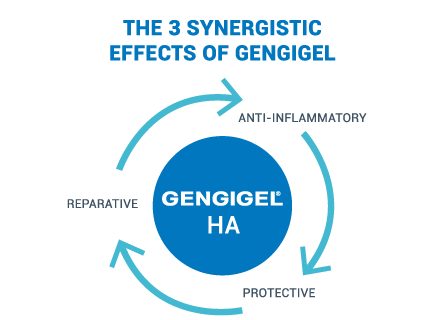



High molecular weight hyaluronic acid (HA) is a natural physiological constituent of connective tissue.
Made up mostly of collagen, it is one of the major components of the human body. HA is the most abundant high molecular weight glycosaminoglycan of healthy
soft periodontal tissues.4 It is active in tissue regeneration and influences the migration of fibroblasts and
fibrinogenesis, thus making the healing of tissue easier. It performs 3 synergistic effects: anti-inflammatory,
accelerates the healing process and provides a protective barrier.
Contributing to the barrier function and tensile strength of the periodontal ligament, HA is essential for healthy
gingival tissues. In the initial stage of inflammation and periodontal disease, tissue’s requirement for HA
increases by 200%, demonstrating its central role in regulating cell turnover and optimizing tissue regeneration.
When lacking HA, healing will be delayed and inflammation will continue.
• Bacteriostatic effect
• Improves tissue regeneration process (supports natural healing process)
• Modulates effect on inflammation

Helps to relieve pain and reduce gingival inflammation associated with:
Medicinal Ingredients
• 0.2 % Hyaluronic acid
• 7.5 % Xylitol (extracted from birch and beech trees)
Non-Medicinal Ingredients
Water, cellulose gum, alcohol, PEG40 hydrogenated castor oil, polyvinyl alcohol, polycarbophil, 2,4 dichlorobenzyl alcohol, flavor, sodium hydroxyde, CI 42090.
Citromint
80046557
• Geriatrics
• Oral Lesions
• Oncology treatment
• Pediatrics
• Periodontitis
• Xerostomia
Adults and children 3 years and older
2 to 3 times a day after meals, for 3 to 4 weeks continuing until all symptoms have disappeared
1. Use an antibacterial toothpaste (X-PUR Remin) or oral rinse (X-PUR Opti-Rinse).
2. Apply a film of gel onto the gingival tissue, massaging gently with clean fingers to aid correct distribution on the mucosal surface.
3. Do not eat, drink or rinse for 30 minutes.
Pregnant or breastfeeding, consult a health care professional prior to use.

High molecular weight hyaluronic acid (HA) is a natural physiological constituent of connective tissues. It is the most abundant high molecular weight glycosaminoglycan of healthy soft periodontal tissues.4
Xylitol is a 100% natural sweetener derived from vegetable sources. Twenty years of research shows xylitol efficacy treating dry mouth and reducing tooth decay.
I have had such good response to the Gengigel! Wow. I've had some nasty, big, long subling ulcers come along and I applied the gel chair side and the patients reported relief from the gel in minutes- amazing. Patients are so grateful! Yesterday I tried it on a geographic tongue that was sore with a "flare up" and same thing- sheer excitement for the patient. She's suffered with these bouts of tenderness forever, but not anymore!
- Christine, a dental hygienist from British Columbia
I randomly stumbled upon gengigel in the pharmacy when searching for a treatment for a terrible canker I had. Ive had cankers my whole life, I get them from mouth trauma (e.g. biting cheek). Anyways, Ive tried everything.. alum, baking soda, kanka, etc etc. Nothing really works. Well, gengigel has been a life saver. You may not feel it working when you initially put it on, but this stuff got rid of my canker in 2 DAYS, 2 DAYS people. Thats unheard of for me. The best part is it easy to apply (don't need to let it try), it tastes like nothing, and its NOT toxic is swallowed. I can't even believe how well it works! I apply several times a day and have seen great result. Would def purchase again.
- Penny, a patient